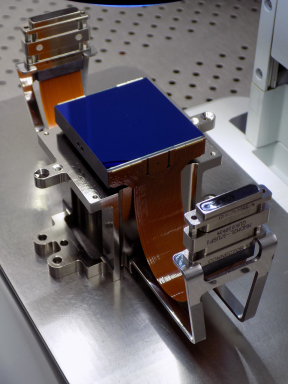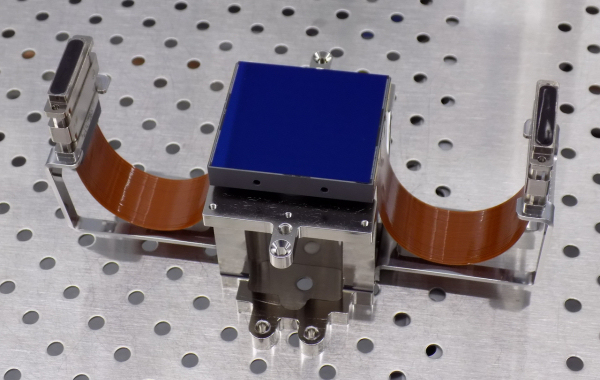First Euclid flight hardware delivered
7 February 2017
An important milestone has been passed in the development of Euclid, a pioneering ESA mission to observe billions of faint galaxies and investigate the nature of dark matter and dark energy. The first flight hardware, in the form of four detectors known as Charge Coupled Devices (CCDs), has been delivered to Mullard Space Science Laboratory (MSSL) by UK company e2v. The remaining flight CCDs (36 in total) for the visible imager (VIS) will be delivered to MSSL by June."This on-time delivery by e2v is a big achievement and an important step for us as we aim towards a launch at the end of 2020," says Giuseppe Racca, ESA's Project Manager for Euclid.
The VIS instrument is being built by a consortium of nationally funded institutes led by MSSL. VIS is one of two powerful scientific instruments to be carried by Euclid.
The VIS CCD detectors, which are being provided by ESA through a contract with e2v, are tailor-made to meet the demanding requirements of the mission, with extremely high efficiency, low noise, good radiation tolerance, and 12-micron pixels to match the resolution of the telescope optics.
Each large area CCD comprises 4096 pixels × 4132 pixels so that the entire VIS instrument will generate 610-megapixel images – 25 times larger than a top-of-the-range digital camera and with far superior image quality.
"The detectors will undergo extensive calibration at MSSL in Surrey before being integrated into the VIS focal plane at CEA in Paris," says Alexander Short, a Euclid instrument engineer at ESA's European Space Research and Technology Centre (ESTEC) in the Netherlands.
"Meanwhile, the Critical Design Review (CDR) for VIS will take place in the first quarter of this year, followed by the CDR for the telescope later in the year. The VIS instrument will be integrated into the telescope at Airbus facilities in Toulouse in 2018."
 |
| Euclid VIS CCD. Credit: e2v |
The field of view of VIS is 0.78 degrees × 0.7 degrees – slightly larger than the area covered by two full Moons – and the spacecraft will manoeuvre to conduct a sky survey over the course of mission.
"Euclid’s wide angle of view will enable it to survey about 40% of the night sky and detect billions of faint galaxies in only six years," said Giuseppe Racca. "It would take the Hubble Space Telescope's survey camera around 1000 years to do this, because of its much narrower field of view."
The second instrument on Euclid, the Near-Infrared Spectrometer and Photometer (NISP), is also making steady progress, and its first detectors are expected to be delivered in March.
Light gathered by Euclid's 1.2-metre diameter primary mirror will be split and sent to the pair of instruments. Together, they will map the 3D distribution of several billion galaxies spread over the entire extragalactic sky.
This will enable scientists to determine in unprecedented detail the properties of the mysterious dark energy and dark matter which are thought to make up most of the Universe. This should revolutionise cosmology by improving our understanding of the evolution of the very fabric of the Universe since its birth in the Big Bang, around 13.8 billion years ago.
Euclid is an ESA medium-class astronomy and astrophysics space mission. ESA selected Thales Alenia Space as mission prime contractor for the construction of the satellite and its Service Module, with Airbus Defence and Space chosen to develop the Payload Module, including the telescope.
The Euclid Consortium (EC) is a collaboration of nationally funded institutes responsible for the scientific mission, including the scientific instruments and data processing.
For further information, please contact:
Giuseppe Racca
Euclid Project Manager
Directorate of Science
European Space Agency
Email: giuseppe.racca![]() esa.int
esa.int
Alexander Short
Euclid VIS payload engineer
Directorate of Science
European Space Agency
Email: alexander.short![]() esa.int
esa.int




